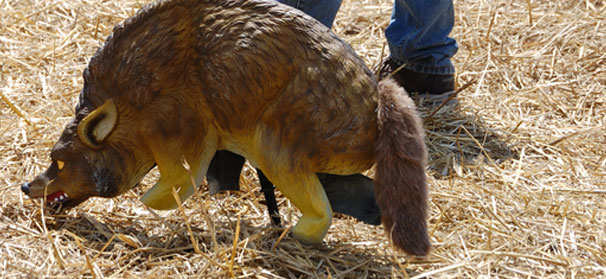

Apr 15, 2011Use ‘animal instincts’ to save your plants
Have you ever seen a scarecrow? You know, the old set of cloths stuffed with straw and made to look like a man out standing in a field, used to scare off crows and other birds?
It is meant to keep critters from eating away the farmer’s profits. That same concept is still in use, although it has taken a much more advanced form.
Today’s fruit growers have many forms of the modern scarecrow at their disposal. This is a good thing, because there is far more than a few birds coming in to eat away profits. Varmints such as rabbits, moles, voles, squirrels opossums, raccoons and more are constantly on the attack.
Please don’t eat me!
With animals, it is instinctual to try to not become a meal for something else. That is where the decoy comes into play. These are products that rely on flashing or predator images to scare nuisance animals away. You have probably seen the owls used to scare pigeons. The predator images tend to work, if they work at all, for only a couple of days. They work better when moved around and not left in one spot, according to the Internet Center for Wildlife Damage Management (ICWDM).
Flashing lights work better for woodpeckers. This is why mylar tape sold under various brand names is used to repel them – but it’s not 100 percent, according to ICWDM.
Of course, you can always have the real thing, too. Michigan grower Robert Wave uses a fence to keep deer out of his blueberries. He electrifies part of the fence during winter months. The upper strands of wire get charged to keep the deer at bay when they might be able to jump over it. The lower strands are left free of charge, so the local coyote and fox populations can get under and clean out any rabbits and mice that might try feeding on the bushes.
The smell of fear
In addition to using visual tactics to keep rodents out of your orchard, scent deterrents are a potent way to keep your plants safe. Most of the repellent works by emitting an odor that animals associate with predator activity, repelling the animal before it nibbles on plants. Studies have shown that odor-based repellents are more effective than other repellent systems where the animal needs to taste treated plants before being repelled. Once animals are attracted to an area and begin feeding, it is more difficult to discourage them from returning.
Olfactory repellents are the Holy Grail of repellents and, like the Holy Grail, just as elusive, according to ICWDM.
You may have heard of using fox or coyote urine to drive away woodchucks. While it can work, generally the woodchuck will adapt – especially if there aren’t any predators around. You also have to consider the threat animal urine or smells may be to your nose or health.
Mothballs are a common repellent. They are avoided by animals, but rarely do they actually repel an animal – including snakes – for all the animal has to do is get by the mothball, according to ICWDM.
ICWDM was funded through a grant from the National IPM Network and the Cooperative State Research, Education and Extension Service. The principle investigators are wildlife specialists Scott Hygnstrom, a professor at the University of Nebraska; Paul Curtis, an assistant professor at Cornell University; Robert Schmidt, an associate professor at Utah State University; and Greg Yarrow, an associate professor at Clemson University. The website coordinator is Stephen Vantassel from the University of Nebraska.
By Derrek Sigler














